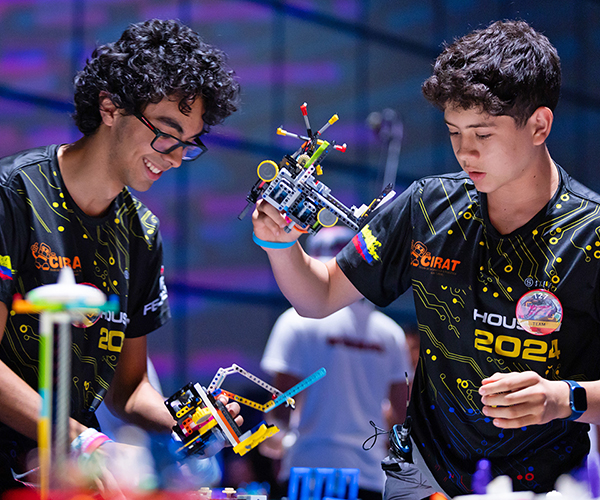Be involved. It’s the best thing you can do to help your child fulfill her potential — academic or otherwise.
Then, act as a guide on your child’s learning journey, from the day she is born to the time she graduates from college.
That may seem like a lot of pressure. But there are strategies to help us make learning an everyday affair. We’ve polled child-development experts, nutritionists and doctors to find 10 very doable techniques for fostering curiosity, confidence and great learning her whole life through.
But first, a simple gesture might be the most meaningful. “Smile at your children,” says Barbara Haxton, executive director of the Ohio Head Start Association. “Make sure they understand that they are OK even when their behavior is not. Let them know you like them.”
1. Capture every teachable moment.
Haxton notes that teachable moments are happening all around us every day.
“You just have to be aware of helping children make connections by describing and labeling things they can observe and things that are happening.”
For example, when climbing the stairs together, count the stairs aloud; when riding on the bus, point out the scenery; as you open a door, say “open” and “close” as it closes.
“Children’s brains are susceptible to learning about these kinds of connections until about 3 years of age. Take advantage of this and make everything you do teachable.”
2. Eat whole foods.
Make sure your kids are getting plenty of vegetables, fruits, meat and nuts, says Shannon Thomas, a certified holistic health counselor, also certified by the American Association of Drugless Practitioners (AADP).
“When you eat highly processed or fragmented foods, you create fragmented thoughts,” suggests Thomas. “When you eat whole foods, you create whole thoughts.”
Try packing lunches with sandwiches made with almond butter or unsweetened apple butter on whole-grain bread, Thomas recommends. If your child wants lunch meat, there are nitrate-free options available at any local health-food store — look for meat that has been grass fed and is free of antibiotics and hormones. The same is true for cheese slices.
“Simple carbs and sugars cause a blood sugar rush in the system, affecting the entire body — including thought processes — and decreasing the ability to think and learn,” she says. “But whole foods give the body and brain sustained energy for thinking.”
Carrot soup is a nice sweet soup that kids love; tomato soup is also a great option. Make a big pot and freeze individual serving sizes — warm it up and bottle it in a thermos in the morning.
For a snack, give your child a hard-boiled egg with a little pesto or just a sprinkle of sea salt. Or try carrot or celery sticks, apple wedges, grapes — any seasonal fruit or vegetable. For a sweet dip, mix two parts tahini to one part honey.
If you have a picky eater, upgrade the quality of your ingredients rather than sending new things. For example, if your child loves peanut butter and jelly, read the ingredients to make sure there are no partially hydrogenated oils in the peanut butter (a good quality peanut butter has a layer of oil on top that you have to mix in) and buy fruit juice-sweetened jelly instead of the sugar-filled varieties.
3. Talk and read. A lot.
Talking and reading with our children, even before they can talk to us, helps build the foundation for literacy.
“Use lots of different words to improve and increase your child’s vocabulary,” says Haxton. Children who have not been actively talked and read to have vocabularies of fewer than 700 words at age 3. Children who have been deliberately chatted up know more than 1,500 words by age 3, which is a crucial age. This type of learning continues as they grow older, as well.
An increased vocabulary accounts for higher reading scores and fewer reading problems once these children reach elementary school. A wonderful, natural way to introduce language to children is through sharing a book.
“Read to them as much as possible,” she says.
4. Schedules are critical.
Predictability and scheduling make the difference between an ordered life and one filled with chaos. As you might imagine, chaos breeds restlessness and disorganized thoughts and actions — not conducive to good learning. Children from underprivileged communities most frequently live in some form of chaos, Haxton says. “Scheduling is a major issue. In Head Start, we teach parents that children must get up and go to bed at regular hours, eat at around the same times each day,” she says. “This type of structure does wonders to foster a learning
environment.”
For children who are in school, this should include doing homework at the same time each day.
5. Sleep tight.
A good night’s sleep is extremely important.
“If kids are going to school tired, they won’t be able to pay attention,” says Dr. Howard Jacobs, assistant clinical professor on the clinical staff of Rainbow Babies and Children’s Hospital, and managing partner of UHMP Pediatricenter of Greater Cleveland. “Most children need 10 hours of sleep, and some need even more.”
Elementary-schoolers getting up at 7 a.m. should be in bed by 8 p.m. the night before. Sound impossible? Try doing quiet activities such as reading, bathing or softly singing to wind down before bedtime. “Children love to hear stories from chapter books night after night as their bedtime story,” says Jacobs. “It gives them something to look forward to about bedtime.”
Jacobs notes that if your child snores or has an airway obstruction, he could have a sleep issue that can be investigated by an ear, nose and throat doctor. However, he stresses, discuss these issues first with your child’s physician, who will determine whether you should contact a specialist. “These issues can interfere with sleep and affect a child’s ability to learn.”
6. Let children do things themselves.
Too often, parents get trapped doing everyday tasks for their children simply because it’s faster and easier.
“Children learn so much from the simple act of doing everyday things on their own,” says Jennifer Massiello, principal of Peaceful Children Montessori School in Kirtland.
Duties that create responsibility toward school, such as packing lunch, preparing homework and assembling the backpack, should be delegated to your child, even if she struggles to accomplish the tasks at first. It may require a little extra time and patience on your part, but everyone will be better off in the long run.
7. Everyday practice.
“Children learn best through life experiences,” says Rosemary Weizer, director of Solon’s Sylvan Learning Center. “Anytime you can relate learning to real life experiences, children are more likely to understand that information.”
Weizer suggests inviting your child to assist with household tasks that incorporate reading, writing and math practice, but outside of the classroom context. A great example is with a grocery list and budget. Let your child write out your list, help figure out a budget and read it back to you while shopping. She’ll feel proud to be using skills learned in school to be helpful to you at home.
8. Let them make their own decisions (within reason).
“Help children learn to make decisions by offering them choices within a framework,” says Peaceful Children Montessori’s Jennifer Massiello.
For example, rather than demanding Junior do his homework, ask if he wants to start with reading or math. “It helps children feel they are a part of things,” says Massiello, “that they have some say in how their world works.” This, in turn, inspires confidence and helps children to be active in their learning.
9. Eat protein for breakfast.
Protein helps avoid the post-sugar or simple carb crash-and-burn.
“Breakfast is the most important meal to supply protein,” says Katy Murphy, Shaklee Nutrition representative and mother of two. “It helps to keep active minds engaged and alert for longer amounts of time.” Murphy serves protein shakes and wheat toast or protein powder mixed into oatmeal to her elementary school-aged children for breakfast. “It keeps them focused and energized.”
10. Play learning games.
Games are also a great educational tool, says Sylvan’s Weizer. Engage your family in a regular game-and-puzzle night. This is a great, fun way to spend time together, and board games and puzzles encourage academic development because they depend on analysis and logic. They also help build social skills through teamwork, sharing and taking turns.



